Brian Eno | ||
| Allmusic Biography : Ambient pioneer, glam rocker, hit producer, multimedia artist, technological innovator, worldbeat proponent, and self-described non-musician -- over the course of his long, prolific, and immensely influential career, Brian Eno was all of these things and much, much more. Determining his creative pathways with the aid of a deck of instructional, Tarot-like cards called Oblique Strategies, Eno championed theory over practice, serendipity over forethought, and texture over craft; in the process, he forever altered the ways in which music is approached, composed, performed, and perceived, and everything from punk to techno to new age bears his unmistakable influence. Initially known for playing keyboards and tape recorders in Roxy Music, he left in 1973 and began releasing atmospheric instrumental albums with King Crimson guitarist Robert Fripp, as well as art rock solo albums such as Here Come the Warm Jets and Another Green World. Released in 1978, the groundbreaking Ambient 1: Music for Airports gave a name to the genre that he would be most closely associated with, although Eno would sporadically return to vocal-based songwriting throughout his career. He also became a highly successful producer for rock and pop acts such as U2, Coldplay, David Bowie, and Talking Heads. Brian Peter George St. John le Baptiste de la Salle Eno was born in Woodbridge, England, on May 15, 1948. Raised in rural Suffolk, an area neighboring a U.S. Air Force base, as a child he grew enamored of the "Martian music" of doo wop and early rock & roll broadcast on American Armed Forces radio; a subsequent tenure at art school introduced him to the work of contemporary composers John Tilbury and Cornelius Cardew, as well as minimalists John Cage, LaMonte Young, and Terry Riley. Instructed in the principles of conceptual painting and sound sculpture, Eno began experimenting with tape recorders, which he dubbed his first musical instrument, finding great inspiration in Steve Reichs tape orchestration "Its Gonna Rain." After joining the avant-garde performance art troupe Merchant Taylors Simultaneous Cabinet, as well as assuming vocal and "signals generator" duties with the improvisational rock unit Maxwell Demon, Eno joined Cardews Scratch Orchestra in 1969, later enlisting as a clarinetist with the Portsmouth Sinfonia. In 1971 he rose to prominence as a member of the seminal glam band Roxy Music, playing the synthesizer and electronically treating the bands sound. A flamboyant enigma decked out in garish makeup, pastel feather boas, and velvet corsets, his presence threatened the focal dominance of frontman Bryan Ferry, and relations between the two men became strained; finally, after just two LPs -- 1972s self-titled debut and 1973s brilliant For Your Pleasure -- Eno exited Roxys ranks to embark on a series of ambitious side projects. The first, 1973s No Pussyfooting, was recorded with Robert Fripp; for the sessions Eno began developing a tape-delay system, dubbed "Frippertronics," which treated Fripps guitar with looped delays in order to ultimately employ studio technology as a means of musical composition, thereby setting the stage for the later dominance of sampling in hip-hop and electronica. Eno soon turned to his first solo project, the frenzied and wildly experimental Here Come the Warm Jets, which reached the U.K. Top 30. During a brief tenure fronting the Winkies, he mounted a series of British live performances despite ill health; less than a week into the tour, Enos lung collapsed, and he spent the early part of 1974 hospitalized. Upon recovering, he traveled to San Francisco, where he stumbled upon a set of postcards depicting a Chinese revolutionary opera that inspired 1974s Taking Tiger Mountain (By Strategy), another sprawling, free-form collection of abstract pop. A 1975 car accident that left Eno bedridden for several months resulted in perhaps his most significant innovation, the creation of ambient music: unable to move to turn up his stereo to hear above the din of a rainstorm, he realized that music could assume the same properties as light or color, and blend thoroughly into its given atmosphere without upsetting the environmental balance. Heralded by the release of 1975s minimalist Another Green World, Eno plunged completely into ambient with his next instrumental effort, Discreet Music, the first chapter in a ten-volume series of experimental works issued on his own Obscure label. After returning to pop structures for 1977s Before and After Science, Eno continued his ambient experimentation with Music for Films, a collection of fragmentary pieces created as soundtracks for imaginary motion pictures. Concurrently, he became a much sought-after collaborator and producer, teaming with the German group Cluster as well as David Bowie, with whom he worked on the landmark trilogy Low, Heroes, and Lodger. Additionally, Eno produced the seminal no wave compilation No New York and in 1978 began a long, fruitful union with Talking Heads, his involvement expanding over the course of the albums More Songs About Buildings and Food and 1979s Fear of Music to the point that by the time of 1980s world music-inspired Remain in Light, Eno and frontman David Byrne shared co-writing credits on all but one track. Friction with Byrnes bandmates hastened Enos departure from the groups sphere, but in 1981 he and Byrne reunited for My Life in the Bush of Ghosts, a landmark effort that fused electronic music with a pioneering use of Third World percussion. In the interim, Eno continued to perfect the concept of ambient sound with 1978s Music for Airports, a record designed to calm air passengers against fears of flying and the threat of crashes. In 1980, he embarked on collaborations with minimalist composer Harold Budd (The Plateaux of Mirror) and avant trumpeter Jon Hassell (Possible Musics), as well as Acadian producer Daniel Lanois, with whom Eno would emerge as one of the most commercially successful production teams of the 80s, helming a series of records for the Irish band U2 (most notably The Joshua Tree and Achtung Baby) that positioned the group as one of the worlds most respected and popular acts. Amidst this flurry of activity, Eno remained dedicated to his solo work, moving from the earthbound ambience of 1982s On Land to other worlds for 1983s Apollo: Atmospheres & Soundtracks, a collection of space-themed work created in tandem with Lanois and Enos brother Roger. In 1985, Eno resurfaced with Thursday Afternoon, the soundtrack to a VHS cassette of "video paintings" by artist Christine Alicino. After Eno produced John Cales 1989 solo effort Words for the Dying, the duo collaborated on 1990s Wrong Way Up, the first record in many years to feature Enos vocals. Two years later he returned with the solo projects The Shutov Assembly and Nerve Net, followed in 1993 by Neroli; Glitterbug, a 1994 soundtrack to a posthumously released film by Derek Jarman, was subsequently reworked by Jah Wobble and issued in 1995 as Spinner. In addition to his musical endeavors, Eno also frequently ventured into other realms of media, beginning in 1980 with the vertical-format video Mistaken Memories of Medieval Manhattan; along with designing a 1989 art installation to help inaugurate a Shinto shrine in Japan and 1995s Self-Storage, a multimedia work created with Laurie Anderson, he also published a diary, 1996s A Year with Swollen Appendices, and formulated Generative Music I, a series of audio screen savers for home computer software. In August of 1999, Sonora Portraits, a collection of Enos previous ambient tracks and a 93-page companion booklet, was published. Around 1998, Eno was working heavily in the world of art installations and a series of his installation soundtracks started to appear, most in extremely limited editions (making them instant collectors items). In 2000, he teamed with German DJ Jan Peter Schwalm for the Japanese-only release Music for Onmyo-Ji. The duos work got worldwide distribution the next year with Drawn from Life, an album that kicked off Enos relationship with the Astralwerks label. The Equatorial Stars, released in 2004, was Enos first work with Robert Fripp since Evening Star, the 1975 follow-up to No Pussyfooting. His first solo vocal album in 15 years, Another Day on Earth, was issued in 2005, followed by 2008s Everything That Happens Will Happen Today, another collaboration with David Byrne. In 2010, Eno signed to the Warp label, where he released Small Craft on a Milk Sea, a collaboration with Leo Abrahams and Jon Hopkins. The following years Drums Between the Bells featured poet Rick Holland, as well as several vocalists. Eno returned to his ambient style of recording with Lux in late 2012. His next project was a collaboration with Underworlds Karl Hyde. Bonding over a shared love of Afro-beat, the pair worked on intros that Eno had lying around but had never been able to complete, resulting in a surprising collection of unusual pop songs. The finished album, titled Someday World, was issued in May of 2014, followed by the pairs second album, High Life, a scant two months later. Eno went back to working solo for 2016s The Ship. Released in April of that year, it comprised two long tracks totaling 47 minutes. The second, a three-part suite, concluded with a cover of the Velvet Undergrounds "Im Set Free." Later that year, he announced another ambient album, Reflection. Described as a "provocative space for thinking," it consisted of a single nearly hourlong track and was released on New Years Day 2017. During the year, Eno collaborated with pianist Tom Rogerson (of Three Trapped Tigers), resulting in an album titled Finding Shore. Dead Oceans issued the album in December 2017. The following year, Eno and My Bloody Valentines Kevin Shields released a collaborative single for Record Store Day, "The Weight of History" b/w "Only Once Away My Son." Also in 2018, Eno released Music for Installations, a box set compiling rare and previously unissued pieces commissioned for galleries and audio-visual installations. | ||
 | Album: 1 of 45 Title: Here Come the Warm Jets Released: 1973-11 Tracks: 10 Duration: 42:18 Scroll: Up Down Top Bottom 25% 50% 75% Spotify TrackSamples Allmusic AlbumCover | 1 Needles in the Camel’s Eye (03:13) 2 The Paw Paw Negro Blowtorch (03:07) 3 Baby’s on Fire (05:22) 4 Cindy Tells Me (03:28) 5 Driving Me Backwards (05:13) 6 On Some Faraway Beach (04:39) 7 Blank Frank (03:38) 8 Dead Finks Don’t Talk (04:22) 9 Some of Them Are Old (05:14) 10 Here Come the Warm Jets (04:02) |
| Here Come the Warm Jets : Allmusic album Review : Enos solo debut, Here Come the Warm Jets, is a spirited, experimental collection of unabashed pop songs on which Eno mostly reprises his Roxy Music role as "sound manipulator," taking the lead vocals but leaving much of the instrumental work to various studio cohorts (including ex-Roxy mates Phil Manzanera and Andy Mackay, plus Robert Fripp and others). Enos compositions are quirky, whimsical, and catchy, his lyrics bizarre and often free-associative, with a decidedly dark bent in their humor ("Babys on Fire," "Dead Finks Dont Talk"). Yet the album wouldnt sound nearly as manic as it does without Enos wildly unpredictable sound processing; he coaxes otherworldly noises and textures from the treated guitars and keyboards, layering them in complex arrangements or bouncing them off one another in a weird cacophony. Avant-garde yet very accessible, Here Come the Warm Jets still sounds exciting, forward-looking, and densely detailed, revealing more intricacies with every play. | ||
 | Album: 2 of 45 Title: Taking Tiger Mountain (by Strategy) Released: 1974 Tracks: 10 Duration: 48:23 Scroll: Up Down Top Bottom 25% 50% 75% Spotify TrackSamples Allmusic Wikipedia AlbumCover | 1 Burning Airlines Give You So Much More (03:18) 2 Back in Judy’s Jungle (05:16) 3 The Fat Lady of Limbourg (05:06) 4 Mother Whale Eyeless (05:46) 5 The Great Pretender (05:11) 6 Third Uncle (04:50) 7 Put a Straw Under Baby (03:26) 8 The True Wheel (05:12) 9 China My China (04:45) 10 Taking Tiger Mountain (05:33) |
| Taking Tiger Mountain (by Strategy) : Allmusic album Review : Continuing the twisted pop explorations of Here Come the Warm Jets, Enos sophomore album, Taking Tiger Mountain (By Strategy), is more subdued and cerebral, and a bit darker when he does cut loose, but its no less thrilling once the music reveals itself. Its a loose concept album -- often inscrutable, but still playful -- about espionage, the Chinese Communist revolution, and dream associations, with the more stream-of-consciousness lyrics beginning to resemble the sorts of random connections made in dream states. Enos richly layered arrangements juxtapose very different treated sounds, yet they blend and flow together perfectly, hinting at the directions his work would soon take with the seamless sound paintings of Another Green World. Although not quite as enthusiastic as Here Come the Warm Jets, Taking Tiger Mountain is made accessible through Enos mastery of pop song structure, a form he would soon transcend and largely discard. | ||
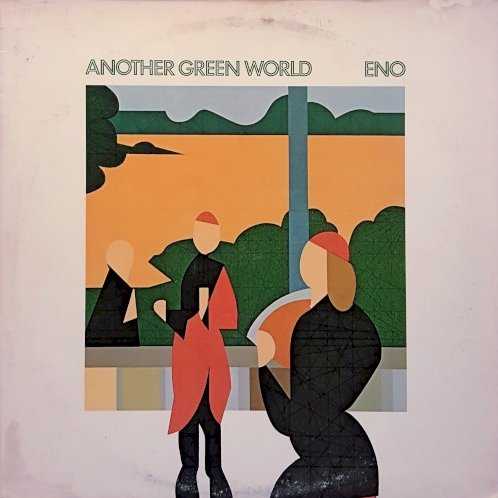 | Album: 3 of 45 Title: Another Green World Released: 1975-09 Tracks: 14 Duration: 00:00 Scroll: Up Down Top Bottom 25% 50% 75% Spotify TrackSamples Allmusic Wikipedia AlbumCover | 1 Sky Saw (?) 2 Over Fire Island (?) 3 St. Elmo’s Fire (?) 4 In Dark Trees (?) 5 The Big Ship (?) 6 I’ll Come Running (?) 7 Another Green World (?) 8 Sombre Reptiles (?) 9 Little Fishes (?) 10 Golden Hours (?) 11 Becalmed (?) 12 Zawinul/Lava (?) 13 Everything Merges With the Night (?) 14 Spirits Drifting (?) |
| Another Green World : Allmusic album Review : A universally acknowledged masterpiece, Another Green World represents a departure from song structure and toward a more ethereal, minimalistic approach to sound. Despite the stripped-down arrangements, the albums sumptuous tone quality reflects Enos growing virtuosity at handling the recording studio as an instrument in itself (à la Brian Wilson). There are a few pop songs scattered here and there ("St. Elmos Fire," "Ill Come Running," "Golden Hours"), but most of the album consists of deliberately paced instrumentals that, while often closer to ambient music than pop, are both melodic and rhythmic; many, like "Sky Saw," "In Dark Trees," and "Little Fishes," are highly imagistic, like paintings done in sound that actually resemble their titles. Lyrics are infrequent, but when they do pop up, they follow the free-associative style of albums past; this time, though, the humor seems less bizarre than gently whimsical and addled, fitting perfectly into the dreamlike mood of the rest of the album. Most of Another Green World is like experiencing a soothing, dream-filled slumber while awake, and even if some of the pieces have dark or threatening qualities, the moments of unease are temporary, like a passing nightmare whose feeling lingers briefly upon waking but whose content is forgotten. Unlike some of his later, full-fledged ambient work, Enos gift for melodicism and tight focus here keep the entirety of the album in the forefront of the listeners consciousness, making it the perfect introduction to his achievements even for those who find ambient music difficult to enjoy. | ||
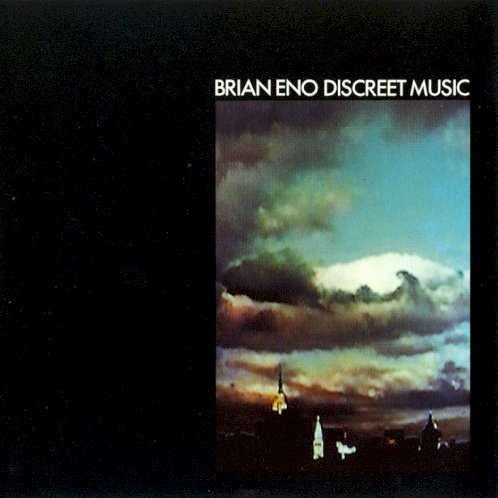 | Album: 4 of 45 Title: Discreet Music Released: 1975-11 Tracks: 4 Duration: 54:07 Scroll: Up Down Top Bottom 25% 50% 75% Spotify TrackSamples Allmusic Wikipedia AlbumCover | 1 Discreet Music (30:35) 2 Three Variations on the “Canon in D Major” by Johann Pachelbel, I: Fullness of Wind (09:57) 3 Three Variations on the “Canon in D Major” by Johann Pachelbel, II: French Catalogues (05:18) 4 Three Variations on the “Canon in D Major” by Johann Pachelbel, III: Brutal Ardour (08:16) |
| Discreet Music : Allmusic album Review : The latter part of 1975 was a remarkably creative period for Brian Eno. With his masterpiece Another Green World, Eno began moving away from the structure and sound of pop music toward a more static instrumental model, influenced in part by Erik Satie and strongly informed by his prior collaborations with Robert Fripp. Recorded just a month after Another Green World, Discreet Music is his first full foray into what has become known as ambient music. Using the same system of two reel-to-reel tape recorders as No Pussyfooting and Evening Star, Eno was able to layer simple parts atop one another, resulting in a beautiful piece of music that never really changes but constantly evolves with the addition and decay of different parts. And while there were elements of noise and dissonance on the albums with Fripp, all the sounds here are calming and serene. The second half of the album deals with the same ideas of recurring themes and evolution but uses a different approach. Here, members of the Cockpit Ensemble use pieces of the score of Pachelbels Canon in D Major, but the relation of these elements changes over time by having the parts slow at differing intervals or using different lengths of the musical score. The same notions of theme and constant variation appear, but without the aid of the tape delay system. The tones of the strings are vastly different from the synth tones of the title track, but the effect on the listener is the same, with the pieces delicately unfolding over time. Discreet Musics reputation as a groundbreaking and influential work is surpassed only by its placid beauty. Highly recommended. | ||
 | Album: 5 of 45 Title: Cluster & Eno Released: 1977 Tracks: 9 Duration: 36:15 Scroll: Up Down Top Bottom 25% 50% 75% Spotify Wikipedia Allmusic AlbumCover | 1 Ho Renomo (05:11) 2 Schöne Hände (03:05) 3 Steinsame (04:13) 4 Für Luise (05:04) 5 Mit Simaen (01:33) 6 Selange (03:35) 7 Die Bunge (03:47) 8 One (06:20) 9 Wermut (03:27) |
| Cluster & Eno : Allmusic album Review : In Brian Enos first collaboration with Cluster, the best of this albums instrumental pieces are too emotionally rich to waste as mere background music, evoking feelings of hesitancy and regret that rescue the music from mere vapid prettiness. Three tracks in particular indicate things to come. "Wehrmut" is an ethereal synth piece with the pace slowed to a tantalizing crawl. "Steinsame" features a treated guitar playing a slow figure over a dark, almost funereal synth melody. "Schöne Hände" uses watery synth effects to highlight a shivery rhythm pattern. Other pieces dispense with moody atmospherics altogether. Tracks like "Ho Renomo" and "Selange" consist mainly of pounding rhythm patterns lightly embellished by piano or synthesizer, and "Die Bunge" sounds like an electronic goldfinch fluttering around a cartoon horse. While not the unqualified success of their 1978 collaboration After the Heat, Cluster & Eno remains an important album. Along with Enos 1978 Music for Films, these works helped define the depth and promise of ambient music. | ||
 | Album: 6 of 45 Title: Before and After Science Released: 1977-12 Tracks: 10 Duration: 39:43 Scroll: Up Down Top Bottom 25% 50% 75% Spotify TrackSamples Allmusic Wikipedia AlbumCover | 1 No One Receiving (03:52) 2 Backwater (03:44) 3 Kurt’s Rejoinder (02:53) 4 Energy Fools the Magician (02:07) 5 King’s Lead Hat (03:59) 6 Here He Comes (05:39) 7 Julie With… (06:20) 8 By This River (03:03) 9 Through Hollow Lands (for Harold Budd) (03:57) 10 Spider and I (04:06) |
| Before and After Science : Allmusic album Review : Before and After Science is really a study of "studio composition" whereby recordings are created by deconstruction and elimination: tracks are recorded and assembled in layers, then selectively subtracted one after another, resulting in a composition and sound quite unlike that at the beginning of the process. Despite the albums pop format, the sound is unique and strays far from the mainstream. Eno also experiments with his lyrics, choosing a sound-over-sense approach. When mixed with the music, these lyrics create a new sense or meaning, or the feeling of meaning, a concept inspired by abstract sound poet Kurt Schwitters (epitomized on the track "Kurts Rejoinder," on which you actually hear samples from Schwitters "Ursonate"). Before and After Science opens with two bouncy, upbeat cuts: "No One Receiving," featuring the offbeat rhythm machine of Percy Jones and Phil Collins (Eno regulars during this period), and "Backwater." Jones analog delay bass dominates on the following "Kurts Rejoinder," and he and Collins return on the mysterious instrumental "Energy Fools the Magician." The last five tracks (the entire second side of the album format) display a serenity unlike anything in the pop music field. These compositions take on an occasional pastoral quality, pensive and atmospheric. Cluster joins Eno on the mood-evoking "By This River," but the albums apex is the final cut, "Spider and I." With its misty emotional intensity, the song seems at once sad yet hopeful. The music on Before and After Science at times resembles Another Green World ("No One Receiving") and Here Come the Warm Jets ("Kings Lead Hat") and ranks alongside both as the most essential Eno material. | ||
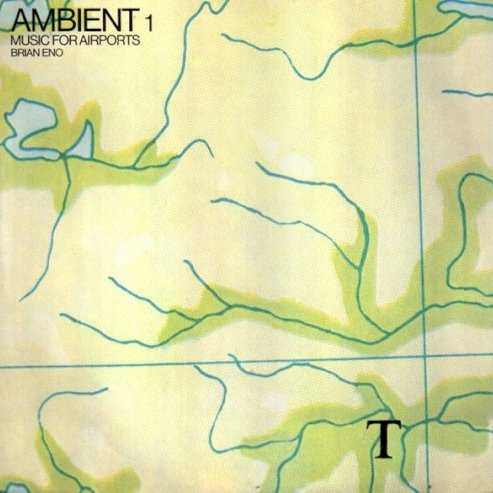 | Album: 7 of 45 Title: Ambient 1: Music for Airports Released: 1978 Tracks: 4 Duration: 48:33 Scroll: Up Down Top Bottom 25% 50% 75% Spotify TrackSamples Allmusic Wikipedia AlbumCover | 1 1/1 (17:25) 2 2/1 (08:54) 3 1/2 (12:05) 4 2/2 (10:08) |
| Ambient 1: Music for Airports : Allmusic album Review : Four subtle, slowly evolving pieces grace Enos first conscious effort at creating ambient music. The composer was in part striving to create music that approximated the effect of visual art. Like a fine painting, these evolving soundscapes dont require constant involvement on the part of the listener. They can hang in the background and add to the atmosphere of the room, yet the music also rewards close attention with a sonic richness absent in standard types of background or easy listening music. | ||
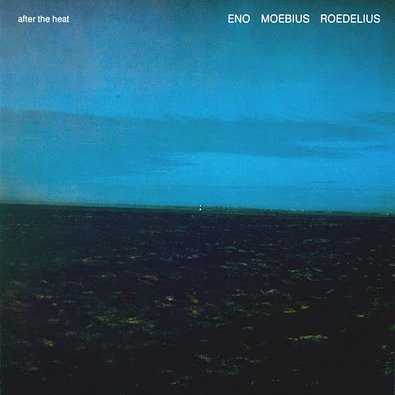 | Album: 8 of 45 Title: After the Heat Released: 1978 Tracks: 10 Duration: 40:56 Scroll: Up Down Top Bottom 25% 50% 75% Wikipedia Allmusic AlbumCover | 1 Foreign Affairs (03:31) 2 The Belldog (06:18) 3 Base & Apex (04:32) 4 Tzima Narki (04:36) 5 Luftschloß (03:14) 6 Oil (04:16) 7 Broken Head (05:27) 8 Light Arms (01:31) 9 The Shade (03:11) 10 Old Land (04:15) |
| After the Heat : Allmusic album Review : Brian Enos second album collaboration with Dieter Moebius and Hans-Joachim Roedelius of Cluster consists of slow-moving instrumentals full of repeated synthesizer sound patterns and sustained guitar notes in the ambient style familiar from Enos collaborations with Robert Fripp and albums of his own, such as Discreet Music. (One song, "Broken Head," features recited vocals by Eno, and on another, "The Belldog," he sings. On "Tzima NArki," he sings backwards.) | ||
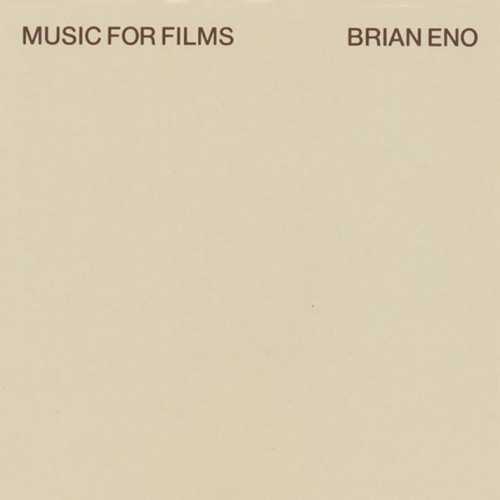 | Album: 9 of 45 Title: Music for Films Released: 1978-10 Tracks: 18 Duration: 41:03 Scroll: Up Down Top Bottom 25% 50% 75% Spotify TrackSamples Allmusic Wikipedia AlbumCover | 1 Aragon (01:37) 2 From the Same Hill (02:59) 3 Inland Sea (01:24) 4 Two Rapid Formations (03:23) 5 Slow Water (03:16) 6 Sparrowfall, Part 1 (01:10) 7 Sparrowfall, Part 2 (01:43) 8 Sparrowfall, Part 3 (01:23) 9 Alternative 3 (03:12) 10 Quartz (02:02) 11 Events in Dense Fog (03:43) 12 ‘There Is Nobody’ (01:44) 13 Patrolling Wire Borders (01:43) 14 A Measured Room (01:03) 15 Task Force (01:22) 16 M386 (02:50) 17 Strange Light (02:09) 18 Final Sunset (04:10) |
| Music for Films : Allmusic album Review : The basic core of tracks making up Brian Enos Music for Films was originally assembled in 1976 for inclusion in a promotional LP of prospective cues sent to film directors. In early 1978, a bit before Music for Airports, Editions EG released Music for Films with little more than Enos cryptic comment: "some of it was made specifically for soundtrack material, (and) some of it was made for other reasons but found its way into films." As with most things Eno, this led to a good deal of speculation and controversy. One filmmaker long ago stated, "All of that is crap -- this music was never used in any films," and another film student who had tried out some of the cues: "this is the worst music for films ever. These cues dont synch to anything." However, the second filmmaker unintentionally discovered the essence of Music for Films -- the 18 pieces here are little films, stimulating the visual part of ones brain and thus fulfilling their promotional purpose. In that sense, Music for Films was revolutionary in 1978. Enos analog music definitely benefits from presentation in the digital domain. The American LP of Music for Films was terrible, crackly sounding, and impossible to track properly. In this new Original Masters "Soundtracks Works" edition, this additional layer of sonic sludge is gone, revealing that the musical textures are simpler than they seemed on the vinyl, rendering details previously inaudible, such as the bass line in Two rapid formations. This CD offers only the same 40 minutes of music issued in 1978 -- "extras" are included on the newly compiled companion disc More Music for Films. The pieces are quite short; some, such as Sparrowfall (1) could have gone longer without wearing out their welcome. The upside is that Music for Films can function as "ambient music for people with short attention spans" -- somewhat oxymoronic, as ambient music is not designed to be paid attention to. The mid-70s were still a rather angry period in electronic music at the academic level. Enos approach differed significantly from both that, and from others, in that his music was not pop-oriented either. Music for Films is the unrecognized link between Discreet Music and Music for Airports -- it is essential Eno, and a landmark collection drawn from among his work. | ||
 | Album: 10 of 45 Title: Ambient 2: The Plateaux of Mirror Released: 1980 Tracks: 10 Duration: 39:58 Scroll: Up Down Top Bottom 25% 50% 75% Spotify Wikipedia Allmusic AlbumCover | 1 First Light (07:08) 2 Steal Away (01:29) 3 The Plateaux of Mirror (04:14) 4 Above Chiangmai (02:55) 5 An Arc of Doves (06:29) 6 Not Yet Remembered (03:50) 7 The Chill Air (02:13) 8 Among Fields of Crystal (03:24) 9 Wind in Lonely Fences (03:58) 10 Failing Light (04:14) |
| Ambient 2: The Plateaux of Mirror : Allmusic album Review : The second in Brian Enos ambient series, The Plateaux of Mirrors fuses the fragile piano melodies of Harold Budd and the atmospheric electronics of Eno to create a lovely, evocative work. In sharp contrast to the exaggerated pieces found on his debut, The Pavilion of Dreams, this record finds Budd delivering sharp shards of piano notes pregnant with meaning and minimal in the best sense of the word. Enos unobtrusive electronics add a resonance and atmosphere that draw from the ambient textures found on Discreet Music, Music for Films, and Evening Star. The albums best moments evoke their subject matter efficaciously and effortlessly; "First Light" creates an audible early morning chill, "An Arc of Doves" employs flights of Frippertronics, "Not Yet Remembered" seesaws between sleep and consciousness, and so on. Although neither artist is a musician in the usual sense of the word -- Budds piano playing is still somewhat limited here -- they excel as musical painters. The wisps of synthesizer that snake through the rattling percussion of "Wind in Lonely Fences," the wistful melody held at a remote distance in "Among Fields of Crystal," the unbounded edges of the piano notes on "Above Chiangmai" -- these wash over the listener in a suffusion of sound. The Plateaux of Mirrors remains a fascinating hybrid (as are many of Enos collaborations), reflecting the uniqueness of both composers in a most flattering light. | ||
 | Album: 11 of 45 Title: Fourth World, Volume 1: Possible Musics Released: 1980-01-25 Tracks: 6 Duration: 45:29 Scroll: Up Down Top Bottom 25% 50% 75% Wikipedia AlbumCover | 1 Chemistry (06:55) 2 Delta Rain Dream (03:29) 3 Griot (Over “Contagious Magic”) (04:02) 4 Ba‐Benzélé (06:17) 5 Rising Thermal 14° 16′ N; 32° 28′ E (03:10) 6 Charm (Over “Burundi Cloud”) (21:33) |
 | Album: 12 of 45 Title: My Life in the Bush of Ghosts Released: 1981-02 Tracks: 11 Duration: 40:32 Scroll: Up Down Top Bottom 25% 50% 75% Spotify Allmusic AlbumCover | 1 America Is Waiting (03:38) 2 Mea culpa (03:44) 3 Regiment (03:58) 4 Help Me Somebody (04:19) 5 The Jezebel Spirit (04:57) 6 Qu’ran (03:46) 7 Moonlight in Glory (04:46) 8 The Carrier (03:36) 9 A Secret Life (02:31) 10 Come With Us (02:43) 11 Mountain of Needles (02:34) |
| My Life in the Bush of Ghosts : Allmusic album Review : A pioneering work for countless styles connected to electronics, ambience, and Third World music, My Life in the Bush of Ghosts expands on the fourth-world concepts of Hassell/Eno work with a whirlwind 45 minutes of worldbeat/funk-rock (with the combined talents of several percussionists and bassists, including Bill Laswell, Tim Wright, David van Tieghem, and Talking Heads Chris Frantz) thats also heavy on the samples -- from radio talk-show hosts, Lebanese mountain singers, preachers, exorcism ceremonies, Muslim chanting, and Egyptian pop, among others. Its also light years away from the respectful, preservationist angles of previous generations field recorders and folk song gatherers. The songs on My Life in the Bush of Ghosts present myriad elements from around the world in the same jumbled stew, without regard for race, creed, or color. As such, its a tremendously prescient record for the future development of music during the 1980s and 90s. | ||
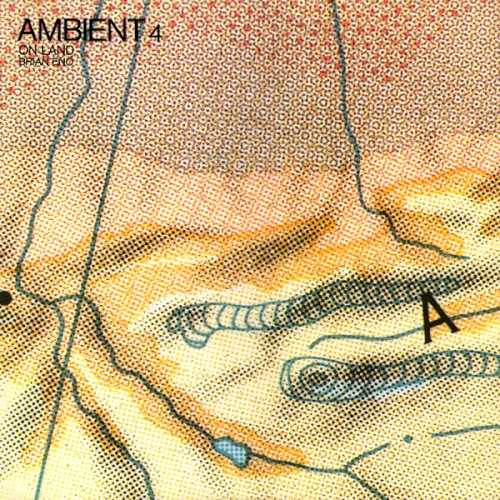 | Album: 13 of 45 Title: Ambient 4: On Land Released: 1982-04 Tracks: 8 Duration: 44:31 Scroll: Up Down Top Bottom 25% 50% 75% Spotify TrackSamples Wikipedia Allmusic AlbumCover | 1 Lizard Point (04:33) 2 The Lost Day (09:12) 3 Tal Coat (05:27) 4 Shadow (03:00) 5 Lantern Marsh (05:33) 6 Unfamiliar Wind (Leeks Hills) (05:26) 7 A Clearing (04:08) 8 Dunwich Beach, Autumn, 1960 (07:09) |
| Ambient 4: On Land : Allmusic album Review : On Land represented a significant move away from the strategies Brian Eno had employed in earlier ambient releases such as Discreet Music and Music for Airports. Instead of using a specific process to generate music with minimal interference from the composer, he here opts for a more gestural and intuitive approach, creating dreamy pictures of some specific geographical points or evocative memories of them. Its quite easy to imagine these works as soundtracks to mysterious footage of imprecisely glimpsed landscapes. On Land is an album that would become highly influential with the rising tide of new age composers, though few if any would capture the chilly beauty or latent romanticism that is part and parcel of Eno. The first piece, "Lizard Point," includes an early recorded performance of Bill Laswell on bass, and one imagines that his association with Eno was a crucial factor in the ambient directions his later work would sometimes take. On Land remains a landmark event in the genre, as well as one of its high-water marks, and sounds entirely up to date 20 years after its initial release. A superb effort. | ||
 | Album: 14 of 45 Title: Music for Films, Volume 2 Released: 1983 Tracks: 13 Duration: 42:38 Scroll: Up Down Top Bottom 25% 50% 75% AlbumCover | 1 The Dove (01:25) 2 Roman Twilight (03:38) 3 Matta (02:25) 4 Dawn, Marshland (03:00) 5 Climate Study (03:20) 6 The Secret Place (03:00) 7 An Ending (03:45) 8 Always Returning I (04:30) 9 Signals (03:59) 10 Under Stars (04:25) 11 Drift Study (02:32) 12 Approaching Taidu (03:27) 13 Always Returning (II) (03:09) |
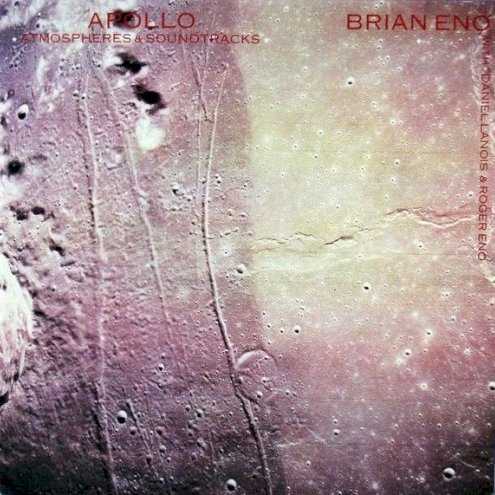 | Album: 15 of 45 Title: Apollo: Atmospheres & Soundtracks Released: 1983-07 Tracks: 12 Duration: 49:18 Scroll: Up Down Top Bottom 25% 50% 75% Allmusic Wikipedia AlbumCover | 1 Under Stars (04:30) 2 The Secret Place (03:29) 3 Matta (04:19) 4 Signals (02:47) 5 An Ending (Ascent) (04:25) 6 Under Stars II (03:22) 7 Drift (03:08) 8 Silver Morning (02:39) 9 Deep Blue Day (03:58) 10 Weightless (04:35) 11 Always Returning (04:04) 12 Stars (07:57) |
| Apollo: Atmospheres & Soundtracks : Allmusic album Review : From Brian Enos Original Masters Soundtracks Series comes Apollo: Atmospheres & Soundtracks. Originally released in 1983 on EG Records, this Virgin incarnation betters the sound quality of the earlier Caroline CD release of this title and is a vast improvement over the vinyl. One can hear super deep tones in the music reproduced for the first time in a full-throated manner, and the perspective of distance opens into vast vistas of the emptiness of space, rather than into a haze of tracking error as did the long player. Apollo: Atmospheres & Soundtracks is usually cited as an Eno album, but it is actually a three-way collaboration between Brian Eno, producer Daniel Lanois, and Roger Eno. It was created for the Al Reinert film For All Mankind, in itself not completed until 1989, but ultimately lauded as the best film documentary on the early years of the NASA space program. Apollo: Atmospheres & Soundtracks, as one would expect, is appropriately spacey and slow moving, but is divided up mostly into rather short cues. Some of the first cues, such as Matta, make use of strategies that are oblique indeed; incorporating a small measure of inarticulate sounds, such as thumping noises, to help build tension, and as such is some of the most challenging ambient music that Eno has written. Enos adherents proclaim Apollo: Atmospheres & Soundtracks as the best of his ambient productions, though it has an Achilles heel. Silver Morning, composed by Lanois alone, seems to stick out like a sore thumb in contrast to the rest of the material, its jangling and bright steel slide being sort of like Michael Hedges suddenly stepping out onto the barren surface of the moon. Deep Blue Day follows suit, but doubtless these tracks would not have been created if they didnt fit what they were intended for, and the participants were so enthusiastic about the two that at one point they were combined onto a limited-edition 45. By the concluding Stars, Apollo: Atmospheres & Soundtracks is back in its element, and this eight-minute ambient track truly is one of Enos finest creations. Even though Apollo: Atmospheres & Soundtracks may be more of a mixed bag compared to, say Music for Airports, as one reviewer said about its corresponding film, it is a shame that Apollo isnt longer than it is. | ||
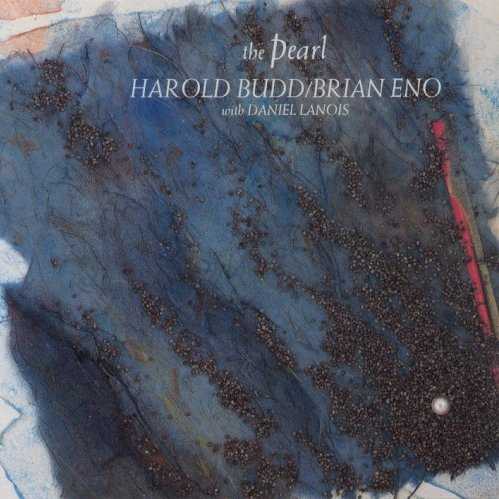 | Album: 16 of 45 Title: The Pearl Released: 1984-08 Tracks: 11 Duration: 42:53 Scroll: Up Down Top Bottom 25% 50% 75% Spotify Allmusic Wikipedia AlbumCover | 1 Late October (04:42) 2 A Stream With Bright Fish (03:56) 3 The Silver Ball (03:30) 4 Against the Sky (04:53) 5 Lost in the Humming Air (04:23) 6 Dark‐Eyed Sister (04:40) 7 Their Memories (02:57) 8 The Pearl (03:13) 9 Foreshadowed (03:54) 10 An Echo of Night (02:27) 11 Still Return (04:14) |
| The Pearl : Allmusic album Review : Hearing Budds piano slowly fade in with the start of "Late October" is just one of those perfect moments -- its something very distinctly him, made even more so with Enos touches and slight echo, and it signals the start of a fine album indeed. Acting in some respects as the understandable counterpart to Ambient 2, with the same sense of hushed, ethereal beauty the partnership brought forth on that album, The Pearl is so ridiculously good it instantly shows up much of the mainstream new age as the gloopy schlock that it often is. Eno himself is sensed as a performer on the album, if not by his absence then by his very understated presence. The merest hints of synth and whisper play around Budds performances, ensuring the latter takes center stage. Eno and Daniel Lanois handle the production side of things, their teamwork once again overseeing a winner. When they bring themselves a little more to the fore, it still always is in the subtlest of ways, as with the artificially higher-pitched notes from Budd on "Lost in the Humming Air." Part of the distinct charm of the album is how the song titles perfectly capture what the music sounds like -- "A Stream With Bright Fish" is almost self-defining. Another key point is how Budd truly captures what ambience in general can and does mean. "Against the Sky" is a strong example -- it can be totally concentrated upon or left to play as atmospherics and is also at once both truly beautiful and not a little haunting in a disturbing sense. Other highlight tracks include the deceptively simple title track, as serene a piece of music as was ever recorded, and the closing "Still Return," bringing The Pearl to a last peak of beauty. | ||
 | Album: 17 of 45 Title: Thursday Afternoon Released: 1985 Tracks: 1 Duration: 1:00:52 Scroll: Up Down Top Bottom 25% 50% 75% Spotify TrackSamples Allmusic Wikipedia AlbumCover | 1 Thursday Afternoon (61-minute version) (1:00:52) |
| Thursday Afternoon : Allmusic album Review : The soundtrack to a VHS cassette of Christine Alicinos "video paintings" (which can be viewed properly only when the monitor is stood on its side), Thursday Afternoon is an hour-long, uninterrupted ambient piece created in Enos "holographic" compositional style, in which even the most brief snippet of music is representative of the performance as a whole. | ||
 | Album: 18 of 45 Title: Textures Released: 1989 Tracks: 21 Duration: 1:10:52 Scroll: Up Down Top Bottom 25% 50% 75% Wikipedia AlbumCover | 1 Soft Dawn (02:18) 2 The Water Garden (02:48) 3 Shaded Water (03:14) 4 Suspicions (04:10) 5 Ozone (01:39) 6 Landscape With Haze (04:04) 7 Mirage (03:18) 8 River Mist (04:29) 9 Constant Dreams (03:53) 10 Dark Dreams (03:05) 11 Black Planet (02:48) 12 Night Thoughts (03:34) 13 Travellers (03:49) 14 Evil Thoughts (01:56) 15 Darkness (01:21) 16 Jungles (01:55) 17 Sanctuaries (01:35) 18 Menace (01:43) 19 Suspended Motion (03:39) 20 The Wild (04:20) 21 River Journey (11:06) |
 | Album: 19 of 45 Title: Wrong Way Up Released: 1990-10 Tracks: 12 Duration: 48:38 Scroll: Up Down Top Bottom 25% 50% 75% Spotify Allmusic AlbumCover | 1 Lay My Love (04:44) 2 One Word (04:34) 3 In the Backroom (04:02) 4 Empty Frame (04:26) 5 Cordoba (04:22) 6 Spinning Away (05:27) 7 Footsteps (03:13) 8 Been There Done That (02:52) 9 Crime in the Desert (03:42) 10 The River (04:23) 11 Grandfathers House (03:07) 12 You Dont Miss Your Water (03:46) |
| Wrong Way Up : Allmusic album Review : Both Brian Eno and John Cale have always flirted with conventional pop music throughout their careers, while reserving the right to go off on less accessible experiments, which means theyve always held out the promise that they would make something as attractive as this synthesizer-dominated collection, on which Eno comes as close to the mainstream as he has since Another Green World and Cale is as catchy as hes been since Honi Soit. The result is one of the best albums either one has ever made. | ||
 | Album: 20 of 45 Title: Nerve Net Released: 1992-09 Tracks: 23 Duration: 1:55:25 Scroll: Up Down Top Bottom 25% 50% 75% Spotify Allmusic Wikipedia AlbumCover | 1 Fractal Zoom (06:26) 2 Wire Shock (05:28) 3 What Actually Happened? (04:43) 4 Pierre in Mist (03:49) 5 My Squelchy Life (04:03) 6 Juju Space Jazz (04:28) 7 The Roil, the Choke (05:01) 8 Ali Click (04:14) 9 Distributed Being (06:11) 10 Web (06:41) 11 Web (Lascaux mix) (09:49) 12 Decentre (03:26) 1 I Fall Up (04:06) 2 The Harness (05:37) 3 My Squelchy Life (04:25) 4 Tutti Forgetti (03:45) 5 Stiff (03:23) 6 Some Words (04:29) 7 Juju Space Jazz (05:18) 8 Under (05:19) 9 Everybody’s Mother (07:08) 10 Little Apricot (03:37) 11 Over (03:51) |
| Nerve Net : Allmusic album Review : For the record, Nerve Net was not Brian Enos first attempt at rock & roll. Not counting his time with Roxy Music, he also made several solo albums in the 1970s that were clearly intended as approaches to pop music -- they were sideways approaches, of course, shaped by the intellectual distance he has always kept between himself and the music that arises from the forces that he puts into motion, and they were far from unqualified successes. But this is his most rocking solo album in years, and also his funkiest. Thats not say its either funky or rock & roll, but it does manage to be lots of fun in a slightly inhuman, claustrophobically funky sort of way. The list of participants includes several of the usual suspects (Robert Fripp, Robert Quine, Roger Eno), as well as a few surprises (Benmont Tench, John Paul Jones) and a raft of unknowns. The sound, which doesnt vary much from track to track, is compressed and dense, with lots of heavily treated and synthesized percussion. On "What Actually Happened," for example, drummer Richard Bailey plays a distinctly organic funk part through what sounds like a battery of effects, while a bassist and guitarist do indistinguishable things and Eno messes around with everything and throws in samples. "Juju Space Jazz" features both Quine and Fripp (the latter credited with "early 50s club guitar") as well as Eno playing such instruments as "African organ" and "tenor fax." Overall, this album is quite fun but nothing to get too awfully excited about. | ||
 | Album: 21 of 45 Title: The Shutov Assembly Released: 1992-11 Tracks: 17 Duration: 1:32:03 Scroll: Up Down Top Bottom 25% 50% 75% Spotify Allmusic Wikipedia AlbumCover | 1 Triennale (04:05) 2 Alhondiga (03:17) 3 Markgraph (03:42) 4 Lanzarote (08:39) 5 Francisco (04:46) 6 Riverside (03:51) 7 Innocenti (04:20) 8 Stedelijk (05:29) 9 Ikebukuro (16:08) 10 Cavallino (03:07) 1 Eastern Cities (04:32) 2 Empty Platform (04:29) 3 Big Slow Arabs (04:39) 4 Storm (06:29) 5 Rendition (05:15) 6 Prague (02:39) 7 Alhondiga Variation (06:33) |
| The Shutov Assembly : Allmusic album Review : If The Shutov Assembly is reminiscent of Brian Enos earlier "ambient" music projects dating back to Discreet Music (1975), it shouldnt be surprising. Recorded between 1985 and 1990, the atmospheric, slow-moving sound patterns are more, the artist contends, like paintings than music. The Shutov Assembly, dedicated to Russian painter Sergei Shutov, is, like the similar works in his catalog (he cites Music for Films, On Land, Music for Airports, Thursday Afternoon, and Nerve Net, as well as Discreet Music), as much a concept as a record. | ||
 | Album: 22 of 45 Title: Neroli Released: 1993-06 Tracks: 1 Duration: 58:03 Scroll: Up Down Top Bottom 25% 50% 75% Spotify Allmusic Wikipedia AlbumCover | 1 Neroli (Thinking Music, Part IV) (58:03) |
| Neroli : Allmusic album Review : Taking a cue from the liner notes, most reviewers of Brian Enos Neroli (1991) point out the pieces simple melodic line, its derivation from the Phrygian mode, its slowly mutating processes, and perhaps also its practical use as background music for therapy. All of these are salient points, and informative to anyone who wonders what this ambient album is like. Yet it might be helpful to mention Nerolis uncanny similarity to the second Environments album, Tintinnabulation (Synthesized Bell Tones), which was created by Syntonic Research, Inc., and released on Atlantic in 1972. Both Tintinnabulation and Enos later work function as soft aural experiences, and resemble each other in their blurred textures and low chiming sonorities. The only substantial differences worth noting are Enos purer tones and cleaner, noise-free atmosphere, which make Neroli more pleasant to hear on a digital player; Tintinnabulation, being an analog recording of comparatively more complex synthesized sounds, has some undesirable production noises, buzzy reverberations, and some detectable tape hiss. But a side-by-side comparison reveals a commonality of purpose as well as similar methods, and both work as "chill-out" discs. Enos CD, however, has the advantage of name recognition, and is therefore more likely to be available. | ||
 | Album: 23 of 45 Title: Headcandy Released: 1994 Tracks: 6 Duration: 1:09:31 Scroll: Up Down Top Bottom 25% 50% 75% Allmusic AlbumCover | 1 [data track] (31:34) 2 Castro Haze (05:55) 3 Manila Envelope (12:14) 4 Spunk Worship (05:34) 5 Beast (06:51) 6 Alloy Balcony & Jets Overhead (07:22) |
| Headcandy : Allmusic album Review : Headcandy brings us back full circle to the trippy light shows of the psychedelic 60s. Featuring a 30-minute dose of pleasing ambient/techno instrumentation (accessible via audio CD player or CD-ROM) courtesy of Brian Eno, the visual effects are multiplied throughout a darkened room by the refractive glasses included with the disc, similar to those cheapie cardboard 3-D movie throw-aways. Unless you must own everything that the prolific Mr. Eno has ever recorded, Headcandy makes an interesting one-time curiosity piece only, about as enduring as black light art. However, this might be practical software for those kind of parties where everyone is equipped with the requisite eyewear and fueled with mind-alterating substances. | ||
 | Album: 24 of 45 Title: Spinner Released: 1995-10-24 Tracks: 10 Duration: 57:02 Scroll: Up Down Top Bottom 25% 50% 75% Spotify Wikipedia AlbumCover | 1 Where We Lived (02:59) 2 Like Organza (02:44) 3 Steam (03:16) 4 Garden Recalled (03:21) 5 Marine Radio (05:06) 6 Unusual Balance (05:23) 7 Space Diary (01:51) 8 Spinner (02:54) 9 Transmitter and Trumpet (08:41) 10 Left Where It Fell (20:42) |
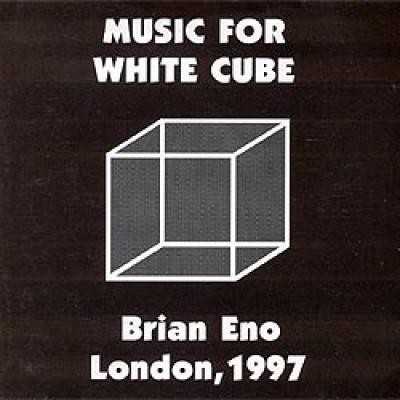 | Album: 25 of 45 Title: Music for White Cube: London, 1997 Released: 1997 Tracks: 9 Duration: 1:08:25 Scroll: Up Down Top Bottom 25% 50% 75% AlbumCover | 1 Notting Hill, Feb 20 (11:45) 2 Old Brompton Road, Feb 20 (03:08) 3 The Oval, Feb 24 (07:06) 4 Regents Park, Feb 1 (24:33) 5 Barbican Station, Feb 24 (01:38) 6 Bermondsey, Feb 24 (04:19) 7 Kentish Town, Jan 29 (02:38) 8 Lavender Hill, Feb 14 (06:57) 9 Camden Town, Feb 24 (06:17) |
 | Album: 26 of 45 Title: Lightness: Music for the Marble Palace Released: 1997 Tracks: 2 Duration: 55:39 Scroll: Up Down Top Bottom 25% 50% 75% Allmusic AlbumCover | 1 Atmospheric Lightness (30:39) 2 Chamber Lightness (25:00) |
| Lightness: Music for the Marble Palace : Allmusic album Review : For a short sabbatical of sorts after the release of The Drop, Brian Eno relocated to St. Petersburg, Russia, and began working on music specifically for installations. Lightness was one of these pieces -- two long ambient tracks, about 30 minutes each, reminiscent of Thursday Afternoon, but with more shine and less glitter. The first track, &"Atmospheric Lightness," has a few more elements, including a high, brittle tone that breaks apart as it gets louder. As this was meant to accompany visuals, it is minimal in the extreme. The original print run was only 500 -- those not bought by gallery attendees were sold privately by Opal Records. However, demand was such that a second run was produced, and may still be tracked down. | ||
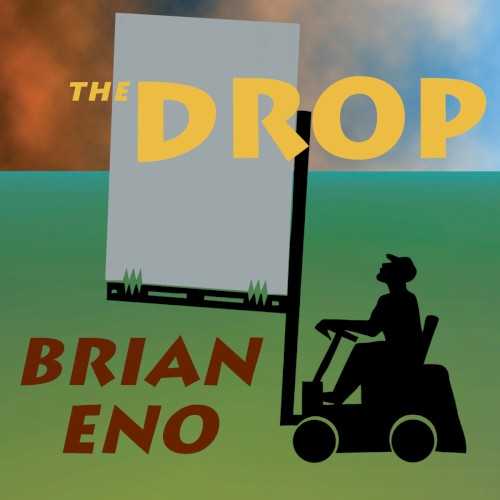 | Album: 27 of 45 Title: The Drop Released: 1997-07-07 Tracks: 17 Duration: 1:14:06 Scroll: Up Down Top Bottom 25% 50% 75% Spotify Allmusic Wikipedia AlbumCover | 1 Slip, Dip (02:18) 2 But If (01:48) 3 Belgian Drop (01:56) 4 Cornered (02:02) 5 Block Drop (02:50) 6 Out/Out (01:51) 7 Swanky (02:50) 8 Coasters (02:55) 9 Blissed (02:53) 10 M.C. Organ (02:54) 11 Boomcubist (02:07) 12 Hazard (02:15) 13 Rayonism (02:55) 14 Dutch Blur (03:02) 15 Back Clack (03:19) 16 Dear World (03:16) 17 Iced World (32:48) |
| The Drop : Allmusic album Review : The Drop finds Brian Eno replicating the floating, trancy sound of Neroli, creating a shimmering collection of ambient music. Although The Drop illustrates that ambient doesnt all sound the same -- it can be soothing and scary, sometimes both at once -- the album doesnt particularly hold the listeners interest, as the shifting electronic soundscapes never reveal any substantial compositions. Its intriguing for a while, but by the time the 74 minutes of The Drop have finished, the album has made little lasting impression. | ||
 | Album: 28 of 45 Title: I dormienti Released: 1999 Tracks: 1 Duration: 39:42 Scroll: Up Down Top Bottom 25% 50% 75% Allmusic AlbumCover | 1 I dormienti (39:42) |
| I dormienti : Allmusic album Review : Music for an installation with Mimmo Paladino at the Roundhouse, London, this one long piece takes its title from Paladino sculptures of prone figures. Over his usual treated piano, Brian Eno drops in sudden sounds: spoken fragments ("ing," "of"), looped, disintegrated, sped up, or brought down into conspiratorial whispers. It strangely turns what is background music into something more participatory -- as if a close listen will reveal a hidden message. One of the more fascinating of Enos hard-to-find installation discs. | ||
 | Album: 29 of 45 Title: Music for Civic Recovery Centre Released: 2000 Tracks: 1 Duration: 44:51 Scroll: Up Down Top Bottom 25% 50% 75% AlbumCover | 1 The Quiet Club (44:51) |
 | Album: 30 of 45 Title: Music for 陰陽師 Released: 2000-02-29 Tracks: 21 Duration: 1:47:12 Scroll: Up Down Top Bottom 25% 50% 75% AlbumCover | 1 双調調子品玄 (04:52) 2 春庭花 唐楽 舞楽 (07:55) 3 黄鐘調調子 (02:40) 4 拾翠楽 唐楽 管弦 ~ 揚眞藻 琵琶秘曲 (04:45) 5 酒飲 催馬楽 廃絶歌曲 呂歌 (03:03) 6 壱越調菅掻 (01:39) 7 陵王乱序 唐楽 舞楽 (09:03) 8 平調調子 (02:52) 9 陪臚破 唐楽 舞楽 (05:43) 10 飛鳥井 催馬楽 廃絶歌曲 律歌 (04:31) 11 盤渉調調子 (04:59) 12 蘇合香 唐楽 舞楽 ~ 青海波 唐楽 舞楽 (14:28) 13 太食調調子 (02:35) 14 長慶子 唐楽 舞楽 (02:59) 15 二星 朗詠 ~ 雲珠 (06:53) 1 Star Gods (07:43) 2 Six Small Pictures (06:07) 3 Connecting Heaven to Earth (03:56) 4 Little Lights (04:34) 5 The Milky Way (02:33) 6 Faraway Suns (03:22) |
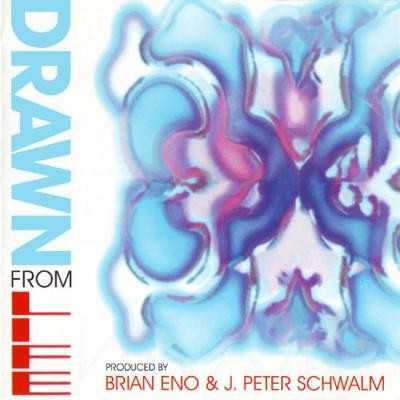 | Album: 31 of 45 Title: Drawn From Life Released: 2001 Tracks: 11 Duration: 1:08:11 Scroll: Up Down Top Bottom 25% 50% 75% Allmusic Wikipedia AlbumCover | 1 From This Moment (01:22) 2 Persis (07:41) 3 Like Pictures, Part 1 (01:20) 4 Like Pictures, Part 2 (05:48) 5 Night Traffic (08:19) 6 Rising Dust (07:44) 7 Intenser (05:23) 8 More Dust (06:03) 9 Bloom (09:40) 10 Two Voices (07:38) 11 Bloom (instrumental) (07:09) |
| Drawn From Life : Allmusic album Review : Following four years after The Drop, Drawn From Life sees Brian Eno collaborating with German DJ J. Peter Schwalm. (Music for Onmyo-Ji, a previous Eno/Schwalm work from 2000, was released in Japan only.) Those who soured at the distant crispness of The Drop will find this to be a more inviting listen, even more so than Enos 1996 collaboration with bassist Jah Wobble on Spinner. Jazzy, shuffling rhythms and strings that sway from cutting to sighing lay the foundation of most of the tracks, with some repetitive nonmusical effects often falling somewhere in the mix. If there is a fault of the record, its that the vocals often get in the way of some fine background listening. If you dont have an affinity for Laurie Andersons voice, you might be troubled that "Like Pictures, Pt. 2," which otherwise happens to be one of the records most melodic and tranquil tracks, is interrupted by her intonations. One might find the babbling contributions from Enos young daughters on "Bloom" to be far less obstructive, but thats because theyre more a part of the fabric of the song, rather than an interruption or distraction. Theres plenty to enjoy for devoted Eno fans, although nothing truly sticks in the mind after the most attentive listen. | ||
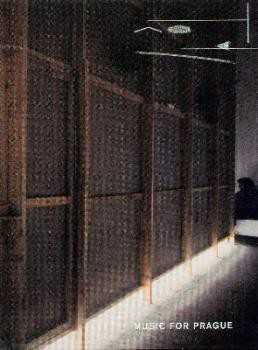 | Album: 32 of 45 Title: Music for Prague Released: 2001-01 Tracks: 1 Duration: 58:44 Scroll: Up Down Top Bottom 25% 50% 75% AlbumCover | 1 Music for Prague (58:44) |
 | Album: 33 of 45 Title: January 07003: Bell Studies for the Clock of the Long Now Released: 2003 Tracks: 15 Duration: 1:18:03 Scroll: Up Down Top Bottom 25% 50% 75% Allmusic Wikipedia AlbumCover | 1 Fixed Ratio Harmonic Bells (23:24) 2 Changes Where Bell Number = Repeat Number (03:32) 3 2 Harmonic Studies (06:07) 4 Deep Glass Bells (With Harmonic Clouds) (03:19) 5 Dark Cracked Bells With Bass (02:02) 6 German-Style Ringing (03:03) 7 Emphasizing Enharmonic Partials (10:42) 8 Changes for January 07003, Soft Bells, Hillis Algorithm (01:28) 9 Lithuanian Bell Study (01:26) 10 Large Bell Change Improvisation (02:48) 11 Reverse Harmonics Bells (01:43) 12 Bell Improvisation 2 (04:01) 13 Virtual Dream Bells, Thick Glass (04:01) 14 Tsar Kolokol III (And Friends) (05:11) 15 1st-14th January 07003, Hard Bells, Hillis Algorithm (05:10) |
| January 07003: Bell Studies for the Clock of the Long Now : Allmusic album Review : January 07003: Bell Studies for the Clock of the Long Now is an ambitious project by Brian Eno, and it is also quite complicated in an extremely intellectual way. The heavy-handed liner notes give a detailed explanation of the algorithms and structures of this monumental CD, but do nothing to enhance the pleasure of listening to this haunting and enchanting music. Eno has taken one of mans oldest instruments -- the bell -- and developed new ways of using its inherent sonorities. His performance and recording techniques give bells deep overtone and drone qualities. The music sounds electronic and Eno merely captures the subtleties of their character. While it might be a bit out of character to compare Eno to anyone -- or anyone to Eno -- this disc is out of character for him. It will remind listeners of Henry Wolff and Nancy Hennings, Klaus Wiese, and Deuter. | ||
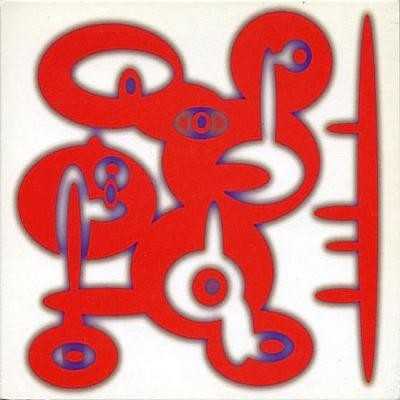 | Album: 34 of 45 Title: Curiosities, Volume 2 Released: 2004 Tracks: 12 Duration: 59:16 Scroll: Up Down Top Bottom 25% 50% 75% AlbumCover | 1 Summer Ride (05:30) 2 Haslet (04:59) 3 Beta Recall (04:21) 4 Move (03:05) 5 Fat Nude Dance (03:01) 6 Native Tambourine (03:18) 7 Bright Alarm (02:14) 8 Watch the World (02:38) 9 Church (08:08) 10 Swept (07:14) 11 Fields of Ice (10:11) 12 Asteroid Dawn (04:32) |
 | Album: 35 of 45 Title: More Music for Films Released: 2005-03-21 Tracks: 21 Duration: 43:24 Scroll: Up Down Top Bottom 25% 50% 75% Spotify Allmusic Wikipedia AlbumCover | 1 Untitled (02:05) 2 The Last Door (01:31) 3 Chemin de fer (01:57) 4 Dark Waters (01:07) 5 Fuseli (01:40) 6 Melancholy Waltz (01:46) 7 Northern Lights (02:13) 8 From the Coast (02:02) 9 Shell (01:26) 10 Empty Landscape (01:26) 11 Reactor (01:40) 12 The Secret (01:13) 13 Don’t Look Back (00:57) 14 Marseilles (01:29) 15 The Dove (01:25) 16 Roman Twilight (03:38) 17 Dawn, Marshland (03:11) 18 Climate Study (03:20) 19 Drift Study (02:32) 20 Approaching Taidu (03:27) 21 Always Returning (II) (03:09) |
| More Music for Films : Allmusic album Review : A listener familiar with the pedigree of the albums of Brian Eno might assume that the Virgin/Astralwerks release More Music for Films is merely a repackaging of Music for Films, Vol. 2, a bonus album included within the LP boxed set Working Backwards. Such an assumption would be incorrect, as More Music for Films represents a new spin on a variety of soundtrack material made by Eno in the years 1976-1983, including some tracks drawn from Music for Films, Vol. 2, others from Eno Box I: Instrumentals, and at least six selections never made public before. According to Virgin, these are taken from the limited-edition promo LP of Music for Films, a two-album set predating the familiar EG release by two years and only circulated to filmmakers and journalists. The last four tracks on More Music for Films relate to Apollo, a justly admired soundtrack jointly created by Eno, Roger Eno, and Daniel Lanois. Some of the previously unissued material is made up of alternate versions of pieces already familiar to listeners who know Enos work well, but still others will appear to be wholly new even to his most seasoned fans. This is part of Virgins Brian Eno - The Soundtrack Series and like the others has been remastered using the Direct Stream Digital method and comes encased in a thick, transparent plastic outer cover. The glue holding this cover together is starting to come apart, even though the review copy has only been in the office a couple of months, so dont expect this part of the package to hold up over time. Enos music, though, has held up remarkably well in face of the enormous changes that have occurred in the realm of pop-oriented electronic music since the last of these tracks were laid down in 1983. Relatively few of these pieces jump out at the listener, and the overall mood fits comfortably within the realm of his ambient music, but taken as a whole the collection has a tad darker atmosphere than, say, Music for Airports. The running time of More Music for Films is certainly more generous than the average entries in Brian Eno - The Soundtrack Series, and even though it is not as essential as the original Music for Films collection, it nonetheless affords a fascinating glimpse into Enos workshop during his early days -- a period some might say was Enos best. | ||
 | Album: 36 of 45 Title: Another Day on Earth Released: 2005-06-13 Tracks: 11 Duration: 46:54 Scroll: Up Down Top Bottom 25% 50% 75% Allmusic Wikipedia AlbumCover | 1 This (03:33) 2 And Then So Clear (05:49) 3 A Long Way Down (02:40) 4 Going Unconscious (04:22) 5 Caught Between (04:25) 6 Passing Over (04:25) 7 How Many Worlds (04:47) 8 Bottomliners (03:59) 9 Just Another Day (04:21) 10 Under (05:19) 11 Bone Bomb (03:09) |
| Another Day on Earth : Allmusic album Review : Finally bored with ambient music, a genre he pioneered in the 1970s, pop polymath Brian Eno emerged with Another Day on Earth, his first solo recording of "conventional" songs since Another Green World. From the rhythm track of opening song "This," the sound is unmistakable. A quirky hook covered in layers of atmosphere and a bouncy loop, its a smart little tune with additional guitars by Leo Abrahams. Lyrically, Enos process is poetic, employing not only his own strategies, but a computer generating words as well. At three-and-a-half minutes, its a fine pop song, albeit one that would never get played on the radio. "And Then So Clear" is more evocative of Enos work with Daniel Lanois, utilizing a very simple loop adorned with sparse guitars while keyboards pulse softly as a completely treated human voice paints a landscape both exterior and interior. "A Long Way Down," is pure mood, a tense, taut mood offered by electric piano, spectral keyboards imitating strings, and the layered guitars of Steve Jones and Abrahams. Eno multi-tracks his voice across the angular melody, and it slips and falls out more than it flows. And thats a basic problem with Another Day on Earth. Once again, despite trying to work with song forms and structures, they feel tossed off, half-baked. "Going Unconscious" isnt so much a song as an ambient soundscape with spoken word accompaniment by Inge Zalaliene. "Bone Bomb" is the same. "Under" feels like a demo rhythm track with a lyric draped loosely over it. But there are some fine moments too, such as "Passing Over" with Jones guitar cruising over the tune like a spaceship and Enos sung lines intersecting at (mostly) just the right moments. "How Many Worlds" is almost a childs ditty full of existential questions. Another Day on Earth is a re-entry for Eno, who has the tremendous pressure of always trying to do something new. Nothing here feels new, but so what? If lightweight, it is often pleasant and amusing, if not utterly engaging. Fans will want to seek it out to see what the brainy one has been up to, but those just coming around should go to the back catalog first. | ||
 | Album: 37 of 45 Title: 77 Million Released: 2006-03-24 Tracks: 9 Duration: 42:10 Scroll: Up Down Top Bottom 25% 50% 75% AlbumCover | 1 Never Stomp (02:34) 2 System Piano (02:04) 3 Bonk 12 (02:58) 4 Luxor Night Car (02:52) 5 Targa Summer (04:58) 6 Cold (02:34) 7 Little Slicer (01:43) 8 Surf Birds (03:38) 9 Targa (18:46) |
 | Album: 38 of 45 Title: Everything That Happens Will Happen Today Released: 2008-08-18 Tracks: 11 Duration: 47:19 Scroll: Up Down Top Bottom 25% 50% 75% Wikipedia Allmusic AlbumCover | 1 Home (05:06) 2 My Big Nurse (03:21) 3 I Feel My Stuff (06:25) 4 Everything That Happens (03:46) 5 Life Is Long (03:46) 6 The River (02:31) 7 Strange Overtones (04:17) 8 Wanted for Life (05:06) 9 One Fine Day (04:55) 10 Poor Boy (04:19) 11 The Lighthouse (03:47) |
| Everything That Happens Will Happen Today : Allmusic album Review : The musical reunion between David Byrne and Brian Eno comes with a fair amount of baggage. After all, they produced some of the greatest records in rock history: the trio of Talking Heads records that Eno worked on, culminating in Remain in Light, and followed by the duos My Life in the Bush of Ghosts, where all manner of Afro-funky beats and freaky sampladelic rhythms were wedded to Pentecostal exorcisms and ceremonial bush chants. Everything That Happens Will Happen Today is a nearly 180-degree turn from the duos collective musical past. These 11 songs are loopy pop tunes that wed Byrnes strange hearing of gospel and folk to Enos continually evolving rhythmic and electronic palette -- they refer to it as "folk-electronic-gospel." Granted, Enos compositional frameworks are all written in major keys, and Byrnes poetically funny, sophisticated lyrics express possibility and hope in the middle of cultural darkness, but while its clear that the emotional component is shared between the two principals, this is far from "message" music. The set opens with "Home." Strummed acoustic guitars and drum loops textured by sonic wonkery introduce an elegantly simple melody where Byrne, at his full-throated best, sings: "The dimming of the light/Makes the picture clearer...I memorized a face so its not forgotten...Come back anytime/And well mix our lives together/Heaven knows what keeps mankind alive/Every hand -- goes searching for its partner in crime." Brokenness and paradox are also addressed: "Home where my world is breaking in two/Home with the neighbors fighting/Home -- were my parents telling the truth?" Likewise, the title track -- with its warm, liquid guitars, out-of-the-ether sonic architecture, and Byrnes lyric coming from both dream and reflection -- is slower and less jaunty, but poetically moving: "Oh my brother, I still wonder, are you all right/And among the living, we are giving/All through the night...." The backing choral voices give the track its "church" feel, but the message is more human and existential than divinely inspired. Another winner is "Life Is Long," which evokes remembrance as the continuation of the chain of human events. Its horn section touches on soul and rhythm & blues, but is blanched and diluted wonderfully. The only track that consciously attempts the rhythmic complexity of anything on My Life in the Bush of Ghosts is "Poor Boy," which is cosmic science-fiction white-boy funk at its best. Its a warning against following the established order and rampant, empty materialism for their own sake -- its guitar riff comes straight from the Rolling Stones "Brown Sugar." Everything That Happens Will Happen Today is, despite the long odds, an inviting, musically satisfying endeavor. It reveals that veteran artists are capable of redefining themselves when refusing to take themselves too seriously. This is unfettered joyful listening. | ||
 | Album: 39 of 45 Title: Making Space Released: 2010-06 Tracks: 9 Duration: 39:43 Scroll: Up Down Top Bottom 25% 50% 75% AlbumCover | 1 Needle Click (04:08) 2 Light Legs (03:38) 3 Flora and Fauna / Gleise 581d (03:55) 4 New Moons (04:02) 5 Vanadium (01:56) 6 All the Stars Were Out (03:53) 7 Hopeful Timean Intersect (05:12) 8 World Without Wind (05:24) 9 Delightful Universe (Seen From Above) (07:32) |
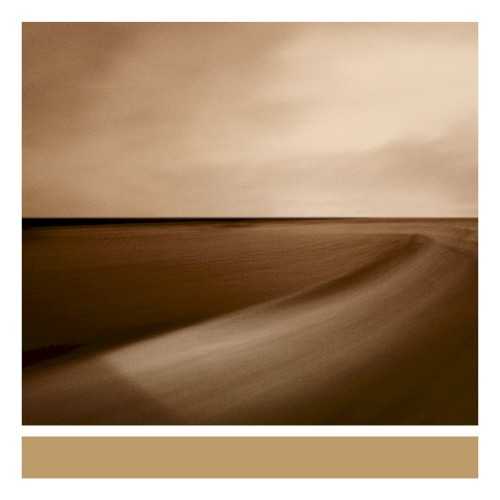 | Album: 40 of 45 Title: Small Craft on a Milk Sea Released: 2010-10-21 Tracks: 4 Duration: 11:53 Scroll: Up Down Top Bottom 25% 50% 75% Spotify Allmusic Wikipedia AlbumCover | 1 Surfacing (02:19) 2 Square Chain (02:35) 3 Bimini Twist (03:13) 4 Abandoned Ship (03:44) |
| Small Craft on a Milk Sea : Allmusic album Review : Brian Enos best recordings are timeless. Even his great recordings are practically timeless. His recordings after the 80s, however, gradually acquired a different description: dated. Released in 1992, Nerve Net attempted to cross both his ambient and pop records of the 70s with faddish techno, while The Drop invoked his ambient period to a sterilizing effect. (Even ambient records need some ambience.) His work of the 2000s was heavily collaborational, fortunately showing him to be still curious about the varieties of musical expression -- beyond what hes been able to display while producing for U2 and Coldplay. Small Craft on a Milk Sea regains the timeless, ageless feel of his best ambient work. It stands as his first record for Warp, a label that has long worshiped at the altar of headphone electronica, although much of this album is the fruit of sessions originally recorded (but declined) for the Lovely Bones soundtrack; some of it was written and recorded by Eno and frequent collaborator Leo Abrahams while they were touring Everything That Happens Will Happen Today, Enos 2008 pop album with David Byrne. Warp has been known for quality control for over 20 years, and this one is no different -- its the best Eno record in 20 years (although thats not saying much). The opener, "Emerald and Lime," is a piece of bright ambience -- as close to a Starbucks soundtrack as a stereotypical Eno work can get. The title track has the dark textures of the later ambient works (Ambient 4: On Land), while the middle section has nods to contemporary electronic music -- "Flint March" is pummeling, percussive techno, and the next track, "Horse," also indulges -- then its back to opaque, spacious ambience with "Calcium Needles" and "Emerald and Stone." Here too, some tracks have the earthy bass of Ambient 4: On Land, others the formless but inviting void of Discreet Music, still others the heart-stopping piano isolationism of the original Ambient 1: Music for Airports. Eno may be trading on his earlier developments in ambience to a small degree, but Small Craft on a Milk Sea is a good and proper balance of curiosity and expression. | ||
 | Album: 41 of 45 Title: Drums Between the Bells Released: 2011-06-22 Tracks: 17 Duration: 52:59 Scroll: Up Down Top Bottom 25% 50% 75% Spotify Allmusic AlbumCover | 1 Bless This Space (03:47) 2 Glitch (02:57) 3 Dreambirds (02:25) 4 Pour It Out (03:37) 5 Seedpods (02:49) 6 The Real (06:55) 7 The Airman (03:13) 8 Fierce Aisles of Light (02:38) 9 As If Your Eyes Were Partly Closed as If You Honed the Swirl Within Them and Offered Me the World (01:38) 10 A Title (03:51) 11 Sounds Alien (02:53) 12 Dow (02:41) 13 Multimedia (01:57) 14 In the Future (02:11) 15 Cloud 4 (01:43) 16 Silence (00:58) 17 Breath of Crows (06:46) |
| Drums Between the Bells : Allmusic album Review : Drums Between the Bells is a collaboration by producer Brian Eno and poet Rick Holland. It was recorded just after Eno finished work on 2010s Small Craft on a Milk Sea, his debut for Warp, and it followed on the release schedule less than a year later. In that sense, the timing was good for such a risky project. Music and poetry are often difficult companions, and combining them is best left to experts; fortunately, Eno is just such an expert. Although Holland is an obscure poet, he first came to Eno’s notice back in the late ‘90s (through a university project), and his poetry is very good. Although his words and thoughts are impressionistic, his themes are easier to peg: urban living, science, and the intersection of philosophy and biology. The music is almost entirely Eno’s own, with only a few tracks featuring guest credits -- much less so than his previous album. While scattered moments here prove that percussion is still not his strong suit, the production is inviting, innovative, and a larger contributor to the general excellence of the record than the poetry. Eno draws mostly on ambient music for these productions, and only occasionally processes the vocals. One other characteristic, aside from Eno and Holland, makes this an unlikely success: there are a total of nine voices heard here (Holland only recites on one track). The decision to vary the speaking participants helps distinguish each piece, and gives the album just the hint of variety it needs. | ||
 | Album: 42 of 45 Title: LUX Released: 2012-11-07 Tracks: 4 Duration: 1:15:19 Scroll: Up Down Top Bottom 25% 50% 75% Spotify Allmusic AlbumCover | 1 LUX 1 (19:20) 2 LUX 2 (18:13) 1 LUX 3 (19:19) 2 LUX 4 (18:27) |
| LUX : Allmusic album Review : On his third offering for Warp, Brian Eno returns to ambient music once again. He displayed it on his label debut, 2010s Small Craft on a Milk Sea, but the various pieces on it were either rejects from The Lovely Bones soundtrack or developed with Leo Abrahams on the Everything That Happens Will Happen Today tour. The music on Lux is a single, 75-minute composition divided into four segments that are between 18 and 20 minutes. They were composed to accompany an exhibit of Enos visual art in Turin. Lux adheres to his ambient principle of making music that is "rewarding attention but not being so strict as to demand it. There is an elemental drift in all four parts of this work, but thats not all there is. Aided once again by Abrahams on Moog guitar, and violins and violas by Neil Catchpole, Enos electronic textures and drones are also accented by the pianos stray single notes or minimal chords, and skeletal use of bass and/or acoustic guitar. But that sense of drift, while inescapable, is actually deliberate and tactile. Music swells and wanes. Alterations of mood and the suggestion of various light shades can be altered in startling fashion--15:47 of "Lux 1," when the pieces tonality drops with piano keys played in the lower register deliberately adding an ominous sense of drama. Here again, Enos sense of creating space all around the droning themes simply moves one idea along to the next place. As each section fades and disappears, the next emerges, unobtrusively, the new one contains only the trace memory of what previously transpired. While each track exists in a self-contained sphere, it is holistic in its relationship to the others. The listeners isnt so much absorbed in actively engaging the composition, but absorbed by it. That said, there is great reward in focusing on what "happens." Thats because Lux betrays implications of vastness just underneath its dulcet tones and restrained palette. | ||
 | Album: 43 of 45 Title: Someday World Released: 2014-04-28 Tracks: 9 Duration: 44:23 Scroll: Up Down Top Bottom 25% 50% 75% Spotify Allmusic Wikipedia AlbumCover | 1 The Satellites (05:33) 2 Daddy’s Car (04:50) 3 A Man Wakes Up (04:17) 4 Witness (05:06) 5 Strip It Down (04:43) 1 Mother of a Dog (05:37) 2 Who Rings the Bell (05:05) 3 When I Built This World (05:44) 4 To Us All (03:28) |
| Someday World : Allmusic album Review : The possibility of Someday World arose when Brian Eno invited Underworld vocalist Karl Hyde to listen to a series of intros hed been unable to finish. The pair share a love for African horns and rhythms as well as dance music of all stripes. Eno enlisted 22-year-old Fred Gibson as a co-producer, and numerous friends including Andy Mackay and Coldplays Will Champion. As much as this album is a collaborative venture -- Hydes vocal and lyrics are indeed signatures -- its music is impossible to separate from Enos career. References to his first four solo records are ample, as is his work with Talking Heads, David Byrne, and even David Bowie. First single "Daddys Car" dives deep into the funk -- Afro-funk, that is -- as its rhythms suggest the influence of the Bhundu Boys drum chorale, as keyboards, fat horns, and squiggly basslines create massive interlocking hooks. Hyde rides them with near pastoral vocal choruses (think "On Some Faraway Beach"). "A Man Wakes Up" uses Juju music organs and jittery synth basslines as Hyde speak/sings a monotone narrative about a man at odds with the speed of life around him even when trying to accept his condition and the world. It unmistakably recalls the same feel as "Once in a Lifetime," especially when the other vocalists and players enter. On "Witness," a bumping bassline and digitally delayed piano vamp introduce a lilting synth melody that contrasts with Hydes single-note vocal about societys collapse: "Did you ever dream the end of the world/Watching everything you loved/Slip beneath the flood." The cascading melodies link through feverish bass and kinetic electronics that flood the piano chords and create lush dreamy pop, under an additional robotic voice intoning about the monotony of everyday life. The moody "Mother of a Dog" weds electro futurism to Middle Eastern trance music via snare, tambourine, tabla, and cowbell loops. But Hydes vocal is at its most emotive as guitars and keyboards shimmer through a swirling, claustrophobic, blurry nocturnal mix. "When I Built This World" opens with a sanguine, nearly romantic vocal from Hyde, but is quickly modulated to mechanization. There are cold pulsing high-register organs, loads of echo, and knotty jazz-rock guitar cadences in tandem with bumping, frenetic basslines (one quotes "Burning Down the House"). Horns and frazzled rhythm guitars slip and quake before his vocals transmute into a completely automatized chorus. The preponderance of funky synthetic (and real) horns, fat grooves, and African and Eastern polyrhythms make Someday World an excellent exercise in beat-conscious, electronic art pop. Though its songs meditate on the nadir of human civilization, more often than not the music stands in stark contrast as it celebrates -- good-naturedly, with irony -- a transcendent human "now-ness," in the twin faces of technological and environmental annihilation. | ||
 | Album: 44 of 45 Title: High Life Released: 2014-06-24 Tracks: 8 Duration: 52:19 Scroll: Up Down Top Bottom 25% 50% 75% Spotify Allmusic AlbumCover | 1 Return (09:00) 2 Slow Down, Sit Down and Breathe (03:04) 3 Lilac (09:24) 4 Moulded Life (04:54) 1 DBF (04:13) 2 Time to Waste It (08:19) 3 On a Grey Day (05:43) 4 Cells & Bells (07:40) |
| High Life : Allmusic album Review : High Life, the second collaboration between Brian Eno and Underworlds Karl Hyde, began immediately after the completion of Someday World. Its release follows a mere two months later. While some traits of the former are present here -- a heavy reliance on African-sourced rhythms, and hypnotically repetitive keyboard and bassline -- it is a very different companion. While the pair relied on more formal "song forms" on Someday World, High Life is looser. These six tracks place more value on jamming. The centerpiece is Hydes guitar. Its front and center throughout, with myriad rhythm tracks close behind. A two-chord reinvention of Chuck Berrys signature riff commences album-opener "Return" before becoming subsumed in sonic treatments and Edge-like sounds. Nonetheless, that vamp worms its way into the brain and feet. Hydes drifting vocal is mixed far underneath his six-string; its negligible. Skittering percussion loops and a droning keyboard eventually come to prominence balanced by an organ playing more like a calliope, building on and subtracting from the riff. A humming bassline merely echoes the guitar changes and it goes on for nine minutes. Though only four minutes, "DBF" is pure funk, with Hydes chunky guitar chords hammering right at the percussion and syncopating it. "Time to Waste It" combines both high life and Caribbean rhythms with a slowly unfolding, merciless repetition that becomes momentum. The heavily treated vocals unhurriedly open out in a bigger circle. Its a "song" that feels like pure improvisation. The proto-disco rhythm guitar in "Lilac" -- featuring the albums silliest lyrics -- is juxtaposed with psychedelia and gospel in the vocals. Enos keyboard treatments pulse; they twist and turn it inside out without forsaking the reverence in or spaciness of the singing, while the guitar keeps the foot race going. "Moulded Life" is careening, chaotic electro Afrofunk -- we could have used much more on this set -- with Adrian Belew-esque guitar parts cutting in a number of directions, as keyboards churn, burp, and crash with dissonance above glitchy rhythm tracks. Closer "Cells and Bells" is an outlier. Given its predecessors, its almost ambient in comparison; its a spectral elegy with a monotone vocal that becomes part of the instrumentation. Theres just enough actual (musical) form to keep the thread, as it is, to a close. High Life sounds like it contains little "strategy." These jams feel spontaneous. The constant repetition with more or less subtle shades of developing dynamic and texture in all but the last of these tracks creates a nearly endless groove. And perhaps thats the albums point, creating an album of dance music thats fun to listen to; a mirror image of Someday Worlds more carefully structured avant pop. | ||
 | Album: 45 of 45 Title: The Ship Released: 2016-03-30 Tracks: 4 Duration: 47:31 Scroll: Up Down Top Bottom 25% 50% 75% Spotify Allmusic Wikipedia AlbumCover | 1 The Ship (21:19) 2 Fickle Sun (i) (18:03) 3 Fickle Sun (ii) The Hour Is Thin (02:50) 4 Fickle Sun (iii) I’m Set Free (05:18) |
| The Ship : Allmusic album Review : The Ship marks Brian Enos first ambient album since 2012s Lux. Work on the album began as a 3-D sound installation in Stockholm, but altered to stereo when Eno realized he could sing in a low C, The Ships root note. The Ship contains two works, the 21-minute title track, and the three-part "Fickle Sun." The title piece, a reflection on the sinking of the Titanic, recalls a moment in his distant past: he released Gavin Bryars Sinking of the Titanic on his Obscure Music label in 1975. The two could not be more different. Bryars work, composed of a folk-like chamber melody, is evolutionary; it changes as the composer learns more about the event. The Ship is self-contained. It emerges from keyboard sounds and samples in a drone that unfolds in gently undulating waves until actual songs -- freed from the concept of fixed rhythm -- emerge. Enos singing voice fronts a two-chord melody that sets his subject inside the frame of a rolling, undulant seascape. The narrative submerges individual stories under a loose but inextricably connected narrative. Softly played keyboards, synthesized strings (suggesting the ships dance band), sonar sounds, sampled ghost voices from radio broadcasts, and a siren chorale (provided by the Elgin Marvels) allow sensory impressions from these fragmented stories to emerge. Enos lyrics depict water, the boat, mortal transience, and the envelopment of it all into a vast, roaring, eternal silence. His singing recedes into droning chords and layers of ambient sound that all but consume spoken voices in Catalan and English. In the end, all that remains are his words, "wave, after wave, after wave." By contrast, "Fickle Sun" begins dramatically. The first section, over 18 minutes, reflects on the "hubris and arrogance" of WWI. Swirling, nightmarish sine pulses, blurry vocals, and colliding keyboards create a dissonant, near-gothic drone. Enos chant-like monotone delivery recalls Nicos doomsday singing. The track builds to a crescendo but its subsumed by a stark, chilly ambience, sampled radio voices and his own, by a vocoder framed by fragmented noise. The feel is sinister and tense. The brief second part (subtitled "The Hour Is Thin") features a lone piano and is narrated by Peter Serafinowicz. It adds poignancy and emotional resonance contrasting sharply with the first. It crossfades into a reverential cover of Velvet Undergrounds "Im Set Free." Aided by Nell Catchpoles violin and viola, Jon Hopkins layered keyboards, and Leo Abrahams guitar, Enos own instrumentation -- including drums -- and singing deliver a gorgeous reading. This pop note -- drenched in the haunted irony of Lou Reeds lyrics: "Im set free/To find a new illusion" -- almost decenters the record but ultimately underscores it as a tender yet powerful commentary. The Ship is a memorial to and meditation on history and human foibles. Just as importantly, it places an exclamation point on Enos career as curiosity, experimentation, chance, and form gel; his relentless sense of adventure remains undiminished by time. | ||